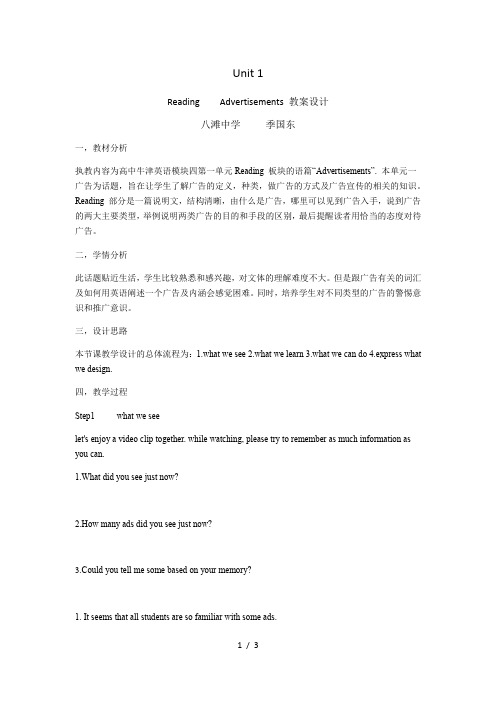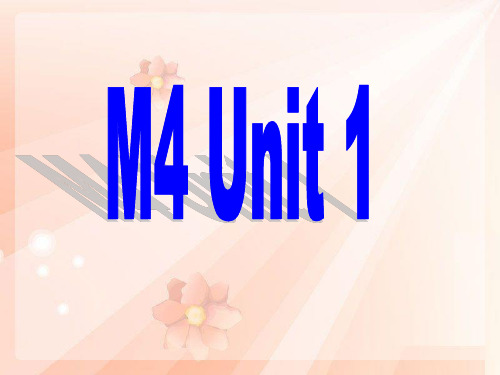牛津高中英语 模块四Unit 1 导入
- 格式:ppt
- 大小:6.18 MB
- 文档页数:37

牛津高中英语教学设计教材:牛津高中英语(模块四)高一下学期文档内容:教学设计单元:Unit 1 Advertising板块:Welcome to the unit课堂设计指导思想:本堂课以听说为主,是整个单元的第一课时,是对整个单元的导入,应起到引导学生对本单元主题即广告业和广告产生情趣。
首先通过让学生欣赏若干精彩的英文广告以激发他们的兴趣;接着通过课本提供的六张图片让学生初步了解广告的基本分类及其相关目的。
学生应积极参与到上述活动中,并在活动中到达操练口语的目的;与此同时,有关“地球日”和“禁毒”内容的公益广告有利于培养学生的高尚情操和社会责任感,这也有助于达成新课程标准中有关情感态度的目标要求。
Teaching aims:1. To enjoy some beautiful advertisements and have a general idea of advertisements.2. To talk about the four advertisements and get some ideas of the two main types of ads and their[ respective purposes.3. To get involved in the discussion and practice spoken English.4.Enlarge the students’ knowledge and make them think about the advantage and disadvantages of ads.Teaching procedures:Step 1 lead-inThe teacher shows the students several beautiful advertisements, among which are both commercial advertisements and public service advertisements.【设计说明】在我们的日常生活中,广告随处可见。

重点高中译林牛津英语模块四Unit1教案————————————————————————————————作者:————————————————————————————————日期:2Module4, Unit1 单元教学设计课题AWE M4 U1 主备人仇晓荣项目目标要求话题Tomorrow’s world语言知识语音Natural and fluent pronunciation and intonation词汇Advertising, advertisement, persuade, promote, welfare, cheat, skilful, innocent, fool, cure, grocery, comment, aim, mental. national, campaign, benefit, consult, latest, recommend, publisher, senior, purchase, designer, tip, slogan, update, youth, aspect, bargain, bonus, fancy, target, determine, analysis, react, personally, poisonous, urge, essay, shockBe meant to, even if/though, fall for, play tricks on, deal with, figure out, appeal to, get something across语法1.Direct speech and reported speech2.Reported speech: statements, questions and imperative sentences功能1.Stating opinions and giving supporting reasons2.Describing an increase, a decrease, no change, a range, an average and a limit语言技能By the end of the unit, students will be able to听listen for statistics and descriptions说Express opinions on advertisements读Read an article about advertisements and two articles related to ad campaigns 写Write an advertisement情感态度Students know and accept diverse cultures and broaden horizon. Students learn how to be cooperative as well as competitive with others.学习策略Summarize what is in listening and reading;put more effort on the difficulties; cooperate with other; expand knowledge about how to read expository writing文化意识1.Differences between commercial ads and PSAs2.Public service advertising campaigns in China注:目标要求可参阅南京外国语学校仙林分校《英语教学实施纲要》第四部分“目标内容”中的相关描述。

Unit 1Reading Advertisements 教案设计八滩中学季国东一,教材分析执教内容为高中牛津英语模块四第一单元Reading 板块的语篇“Advertisements”. 本单元一广告为话题,旨在让学生了解广告的定义,种类,做广告的方式及广告宣传的相关的知识。
Reading 部分是一篇说明文,结构清晰,由什么是广告,哪里可以见到广告入手,说到广告的两大主要类型,举例说明两类广告的目的和手段的区别,最后提醒读者用恰当的态度对待广告。
二,学情分析此话题贴近生活,学生比较熟悉和感兴趣,对文体的理解难度不大。
但是跟广告有关的词汇及如何用英语阐述一个广告及内涵会感觉困难。
同时,培养学生对不同类型的广告的警惕意识和推广意识。
三,设计思路本节课教学设计的总体流程为:1.what we see 2.what we learn 3.what we can do 4.express what we design.四,教学过程Step1 what we seelet's enjoy a video clip together. while watching, please try to remember as much information as you can.1.What did you see just now?2.How many ads did you see just now?3.Could you tell me some based on your memory?1. It seems that all students are so familiar with some ads.Why are you so familiar with them?2.Where else can we often see or read ads?3.Could you tell me what an ad is according to your understanding?Pay attention to the ads. what do they want to sell us?what do these ads have in common?Step2.what we learn1.Do you think ads tell us the complete truth?Read para.3 and answer:1.What are the two examples of CAs given by the writer inthis paragraph?2. How do CAs trick us according to these examples?Read para.4 and answer:1.What do PSAs aim to do?2.What are the examples of PSAs given by the writer in this paragraph?Since China began a nationwide public service advertising campaign 1n 1996, various types of PSAs have appeared.here is one that impresses me most.let's enjoy it togetherand tell me what message the PSA want to convey to us?Step3.what we can doHave you ever thought of designing an ad by yourself? Now you have got a chance. work in groups.Choice 1:Design an ad for your company's chocolate.Choice2: Design an ad for you club to make it famous and attract more students.As to how to design a good ad, you can turn to page 17 for reference (参考).Step4.express what we designStep5.Homework。



牛津高中英语教学设计教材:牛津高中英语(模块四)高一下学期文档内容:教学设计—教案单元:Unit 1 Advertising板块:Task 1作者:唐敏芳课堂设计指导思想:这一板块的设计是对学生进行听说读写技能的训练,而听说读写的内容都围绕本单元主题“广告”展开。
本板块包括的一系列活动为学生提供了锻炼听说读写能力的机会。
本堂课的重点是培养学生在听的过程中获取和处理信息的能力,培养听的策略,培养语感以及口语表达的准确性,得体性和连贯性。
Teaching aims:1. Get to learn and practice the skills of listening, reading, speaking and writing.2. Learn how to listen for statistics and descriptions3. Try to apply the skills learnt in this section to complete a bar chart.Teaching procedures:Step 1 Lead-in (Brainstorming)Ask students to brainstorm how to get information before writing an ad.【设计说明】这一问题的提出既可复习本单元阅读课的内容,又将本堂课的听力训练重点与本单元主题结合起来,自然流畅导入本课。
Step 2 Skills building 1Help students to listen for statistics and descriptions and review how to read these statistics:【设计说明】帮助学生复习分数,小数和百分数的表达方式,并提醒学生注意分数,小数和百分数,特别是小数点后数字的正确读法。
Step 3 NoticeAsk students to listen carefully and pay attention to words and phrases that describe an increase, a decrease, no change, a range and a limit【设计说明】引起学生对这些表达方式的重视,为学生顺利完成后续听力任务扫除障碍,有利于切实提高学生听的能力。
牛津版必修4Unit1 Welcome教案Analysis of the teaching material:This is the 1st period of Unit One. The main purpose of this lesson is to make Ss be familiar with the topic of this unit.Objectives:1.To make Ss identify the differences between these two types of advertisements.2.To practice Ss’ oral English.Teaching approaches:Teaching approaches is the key step for class teaching. Visual-scene teaching method, tasked-based method as well as the approaches of discussion and so on will be adopted in the teaching pr ocess of this lesson. Emphasis will be put on Ss’ ability of speaking, expressing and brainstorming. Language is best learned through activities. I’ll introduce a rich variety of activities and approaches to meet different needs of the Ss and make full use of the advantages of multimedia which is visual, operable to make my lesson vivid, interesting and effective.Interaction Patterns: Teachers -class, individuals, pairsSs’ ability to work both independently and together is very important to their success in the future. It is therefore important for Ss to have opportunities to develop their English skills and knowledge independently, in pairs, in groups and as a class. Teaching Aids: multimedia and a blackboardProcedures for teaching:Step 1 Greeting and Lead-in1.Do you know what title of this unit is?2.Which piece of ad-show do you like best?3.Where can you find these ads and do you like them?Step 2 Welcome to the unit1. Observation: Ask Ss to observe the six pictures on Page 1 and dive them into two parts.2. Discussion: Look at the six pictures and answer these questions:What image(s) can you see on each poster?What can you read on each poster?What can you learn from each poster?Step 3 Pair WorkMore ads for Ss to have a discussion.Step 4 Active reading:Listen to the material on Page 94 and try to answer these questions:1 What’s the ad about?2 What types of things will the stories be judged on?3 What should Ss pay attention to when writing the story?4 Why is it good for Ss to enter English writing competitions?Step 5 Mini-writing:Choose one ad and write something to promote your service or products. Homework1. Collect some advertisements and try to know what products or services the ads talk about.2. Get ready for the Reading part.3. Unit Revision: Period 1.。
Unit 1 AdvertisingWelcome to the unitTeaching Aims:◆To make students aware of the role of advertising in our daily life◆To talk about the six ads and put them in two groups. Finally encourage themto tell the difference between them◆To discuss the last three questions to improve their speaking ability Teaching Key & Teaching Difficulties:◆To help students understand the role of ads◆The usages of some key words.Teaching Procedure:Step One: Leading-inT: (Greeting the class as usual) Now we will talk about advertising. Then bythe way:1)Do you like reading or watching advertisements?2)What kind of ads do you like best? And why?3)Where can you find advertisements?(T can give the students enough time to discuss the questions in pairs orgroups. Any related answers are acceptable. This step is just to arouse theirinterest in the topic.)Ss: … (Encourage them to express themselves)Step Two: SpeakingT: That’s good! So in fact we are living in a world of ads and whether you like or not, they are influencing our life. Ok, now please open your bookto page 1. Here are six pictures. You may have seen some similar to them.Next please discuss them in groups of four and try to answer thefollowing questions:1)What can you see in the picture?2)What can you read on it?3)What does it persuade us to do or what does it try to tell us?Ss: …(Show the pictures in pairs and let the students to discuss them one by one.Remember to give them enough time to think about the above questions)T: Well done! Now you can see that advertisements are a good way to sellproducts or services. They are also a good way to make people aware of theneeds of others and the dangers around them. Next please look at the tablebelow and then go through the six pictures again. Later on put each of themin the correct group.T: Wonderful. I think most of you have realized the difference between the two.And in the reading we will have a further discussion.Step Three: DiscussionT: So, now look at the three questions and discuss them in groups of four.1. Which advertisements make you want to buy a product or service? Why?2. Which advertisements make you think about social problems? Why?3. Do you believe that advertisements tell the complete truth? Why or why not?Ss: …(T can help the students to conduct the activity and encourage them to work together to complete the task. Later let some students to show off.) T: Well done. Now I think most of you have know what an advertisement is and realize the role of them in our life.Step Four: Homework1.Ask students to read the passage in Part B on Page 95 in Workbook as theirhomework. Teachers can check the answers in or after class2.Let them preview the next period, especially the new words in the instructionsor requirements but not included in the wordlist.Unit 1 AdvertisingReading: AdvertisementTeaching Aims:●To learn more about advertisements●To learn how to read a expository writing●To read the passage Advertisements and complete related answers●To improve their reading comprehension skill by fully participating in allactivitiesTeaching Key Points & Teaching Difficulties:◆How to improve their reading ability through teaching activities◆How to let them gain some insight into advertisements and help them dealwith advertisements in their daily life◆The usages of some key wordsTeaching Procedure:Step One: Leading-inT: (Greet the students as usual)In the last lesson we discussed fouradvertisements and talked about their effects on us. Today we will go on tolearn more about ads by reading a passage called Advertisements. Please lookat the title and tell me:➢What might be talked about in the article?Ss: … (Any possible answers are acceptable)(This step is to help them predict the contents of the passage which is of greathelp to improving their reading comprehension ability)Step Two: Reading ComprehensionT: Very Good! Now let’s read the article to check whether your prediction is correct or not. First of all, please open your book to page 2. Go through thequestions in part A first and then read the text silently to find the answers tothe three questions:1)What do ads try to persuade people to do?2)What does PSA stand for?3)What do PSAs aim to do?(Remind students to use skimming and scanning skills to focus on and identify the information needed to answer these questions. Let them pay attention to the three subtitles in the passage which can help them find the information they want. )Ss: … (Encourage them to give their answers in their own words.)Suggested Answers:1)To buy a product service or service, or to believe in an idea.2)Public service advertisements3)They aim to teach us and help us lead better lives.T: Wonderful! Since we read the article once, I think you can a general idea of the passage. But if you want to get a better understanding of the article, you should read an article several times. So please look at Part C1 on page 4. Do the true and false exercise.Part C1:●Most people are not aware of how many ads are around them.●Advertisements are always meant to promote a product or service.●PSAs are only found in newspapers and on TV.●PSAs and commercial ads use some of the same methods.●Commercial ads often give us valuable information about how to live ourlives.●An ad warning people against smoking is an example of a PSA.Ss: … (Ask them finished it individually)Suggested Answers:1. T2. F3. F4. T5. F6. TT: Great! Now I think most of you have got a better understanding of the article.Next let’s go on to do the exercise in Part C2. Please go over the article again and answer the following questions.Part C2:●Where are advertisements usually found?●What is the major distinction between commercial advertisements andPSAs?●Why are some of the advertisements clever according to the article?●When did China begin a nationwide public service advertisingcampaign?●Why should we follow the advice in PSAs?Step Three: Reading StrategyT: Now you have read the article twice. I think most of you have no difficulty in understanding it. Yet different types of passages require different reading strategy. The article we have learnt is an expository writing. Then:➢Do you know how to read an expository article?Ss: No.T: Ok. Please read the reading strategy on page 3 and try to answer the two questions:1)What is expository writing meant to do?2)What is its basic format?Ss: …(Remind them to concentrate on the letters in bold )Possible Answers:1)It is meant to introduce you to basic information on a topic.2)It usually follows the basic format: introduction of the subject, examplesand facts that develop or support the idea, conclusion.T: Good! If you read expository writing in future, remember to use what you have learnt today. It will help you get a good understanding of the passage and improve your reading ability. That’s all for the reading. If you have any problem, please point it out and ask me for help.(Give explanations if necessary and ask them complete the left exercises after class.)The Keys to Part D:1.h2.c3.b4.d5.f6.g7.e8.aThe Keys to Part E:1.dealing withments3.promote4.fool5.even if6.cheated7.campaigns8.benefitStep Four: Post-reading DiscussionT: Well done! Last but not least, work in pairs and discuss these questions with your partner.1)What are the differences between commercial ads and public service ads?2)Do you think young people are easily persuaded by ads? Why or why not?3)What is the best PSA you have ever seen? Why do you think it isimpressive?(This serves as a consolidating exercise for students to practise their spoken English. Encourage them to discuss freely and bravely in English and later ask some students to express themselves.)Step Five: Homework➢to complete the remaining exercises on Page 4 and 5.➢to do parts A1 and A2 on Page 90 in WorkbookUnit 1 AdvertisingLanguage pointsTeaching Aims:Enable the students to learn vocabularies and language points in the text. Teaching important and difficult points:Help the students to use these language points properly.Teaching Procedures & WaysLanguage points:1. An advertisement uses words and pictures to persuade people to buy a product or service, or to believe in an idea. persuade vt.劝说、说服e.g. His friends failed to persuade him to go on the outdoor camping trip.他的朋友们劝他去户外露营,但失败了。